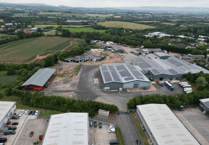NATURE on the National Trust’s Holnicote Estate, on Exmoor, has been feeling the impact of seasonal ‘baseline shift’ and extreme weather events as 2023 looks set to be the warmest year on record - and 2024 is already forecast to be even warmer.
This week, the trust ‘sounded the alarm’ for UK wildlife as the loss of predictable weather patterns and traditional seasonal shifts caused chaos for nature, and it urged politicians to prioritise urgent action to protect nature and people from future climate shocks.
The trust’s head of nature and restoration ecology, Ben McCarthy, said: “The shifting weather patterns we are seeing in the UK, particularly with the warmer temperatures we are experiencing is continuing to upset the natural, regular rhythm of the seasons, causing stress to wildlife and making it more susceptible to pests and disease.
“This loss of predictability causes chaos for the annual behaviours of animals in particular, but can also impact trees and plants.
“The warmer year-round temperatures are resulting in shorter winters which could have particularly devastating impacts for trees, with cold snaps just not long enough to kill off diseases such as oak processionary moth, whose caterpillars infest oak trees, leaving them vulnerable to other threats.
“The spread northwards through Europe from their traditional home in the Mediterranean is a tangible consequence of our warming climate.
“Warmer winters could also impact our heathlands, allowing the heather beetle to take hold, killing off huge swathes of heather.
“It also impacts hibernators like dormice, which may emerge from hibernation early using up vital energy stores, and red deer may leave rutting to later, meaning calves are born in the summer rather than the spring, with insufficient time to grow and put on fat reserves to survive cold snaps.
“It is these baseline changes that we are seeing that are really worrying and what we should be taking more notice of, particularly when combined with extreme weather events, which makes things even more challenging.”
Some of the simplest seasonal shifts noted by rangers and gardeners around the trust’s estate included mowing grass much later until late November, due to grass ‘not shutting down’ because of the warm and wet conditions.
The warm temperatures also resulted in some shrubs budding for a second time or coming into bloom early, making them susceptible to sudden cold snaps, reducing flowering in the spring and summer months, with knock-on impacts for pollinators and seed set.
Mr McCarthy said: "The incremental shifts we are experiencing in terms of our seasons extending may not feel like much in a 12-month period, but over a decade the changes are extremely significant.
“It demonstrates how vitally important it is to continually assess local conditions to ensure that we have the right conservation plans in place to help nature adapt as we begin to see climate change starting to bite.”
Trust national climate change consultant Keith Jones said: “When you consider the extreme temperatures and heatwaves that have devastated parts of Europe and other countries this year, we have been extremely fortunate.
“We were just 1,000 miles away from experiencing a second year of serious drought and record-breaking temperatures which would have had huge consequences for nature, people, and food production.
“But we cannot allow ourselves to be lulled into any sense of false security.
“In the near future we are likely to experience a combination of drought and high temperatures as well as high rainfall and flood, and we need to get ready for this new ‘norm’.
“Water is going to be key – not having enough, and also not too much.”
To help deal with the unpredictability of both the seasons and the weather, and to tackle the climate and nature emergency, the trust has been working hard to make its landscapes more resilient, and able to adapt to the changes.
One key project completed this year to meet the challenges of the climate and nature crisis was the pioneering ‘Stage Zero’ river reset project on the Holnicote Estate, where over three years a section of the River Aller was reconnected to its floodplain to create a new and different waterscape using an innovative restoration technique not previously tried in the UK.
Mr McCarthy said: “At Holnicote, we literally saw more nature move back in, within just three months of the project’s completion as this new complex waterscape started to ‘bed in’ and thrive.
“By viewing the climate and nature crisis as two sides of the same coin, we know projects to help tackle the climate crisis, will also benefit nature, too.
“Once we create the right habitats for nature to thrive, nature will move back in and we can see signs of recovery relatively quickly.
“We therefore need to see more action from politicians throughout the country, particularly as we enter this election year, to ensure tackling the nature and climate crisis is a top priority.
“We want to see parties commit to accelerating progress on nature restoration, increase support for nature-based solutions to climate change, and to put climate adaptation at the heart of their manifestos, so the UK can be better prepared for the weather extremes we will increasingly experience.”
Observational data of red deer calving dates on the Holnicote Estate seemed to indicate that rutting behaviour was extending later into the winter.
The observation was partly supported by research carried out by the Isle of Rum red deer project.
Holnicote Estate wildlife manager Simon Powne said: “We only have two species of native deer in the UK, red and roe deer.
“The consequences of later rutting within the wild deer herd is that the calves are then born later in the year, so in the summer rather than the spring.
“This means they do not necessarily have the time to grow and put on the weight and fat needed to survive over winter, especially if the weather is harsh.
“We intend to focus on gathering the necessary data over the next few years to quantify this further and to better understand what these changes could mean for this special species.”
One success story was the heath fritillary butterfly, which was seen in record-breaking numbers on parts of the Holnicote Estate, with individuals being found at new sites, or sites where they were previously thought extinct.
One site had more than 500 individuals recorded in a two-hour survey.
The weather played a part in promoting good numbers this year as a warm, sunny period of settled weather coincided with the fritillaries’ flight period, which provided perfect conditions for the adult butterflies to emerge and breed.
The species is known to have a ‘boom and bust’ cycle, making use of good conditions some years, and persisting in lower numbers in others, but the Holnicote team was confident in its efforts to promote a sustainable population.
More information can be found on the National Trust’s work to restore landscapes and nature, and donations made, by visiting the trust’s website here.



